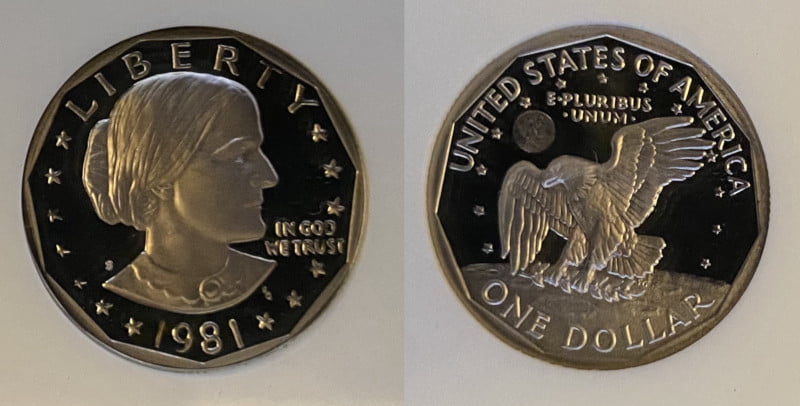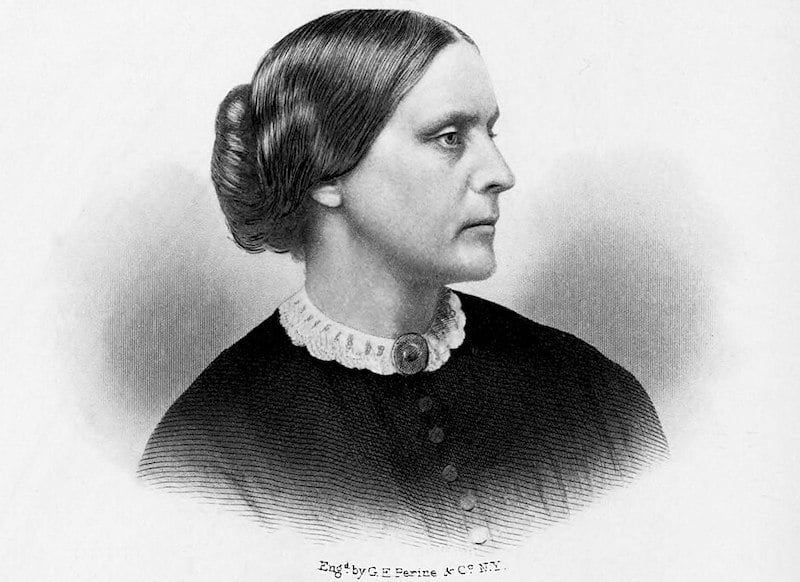Perhaps it isn’t fair to compare the Susan B. Anthony dollar coin to those less-than-successful installments of otherwise well-liked catalogues that were so bad they’re widely disregarded by both their creators and fans.
Or maybe it is.
Like “New Coke,” the U.S. Mint had every reason to assume the Anthony dollar would be a smashing success. Traditional silver dollars were bulky, impractical and with the advent of the Eisenhower dollar in 1971, no longer made of silver. A smaller dollar coin would accomplish several specific policy and political goals – in particular, saving money. Weighing 8.1 grams and measuring 26.5 mm in diameter, the Anthony dollar was much lighter and smaller than the traditional U.S. silver dollar, which typically came in at 38.1 mm in diameter and weighed either 22.68 or 26.73 grams depending on its composition.
Due to the smaller size, the new dollar coin cost three cents to produce, compared to eight cents for an Eisenhower dollar. In addition, they were expected to last 15-18 years in circulation, while a dollar bill only lasted about 18 months. Finally, if the coins could replace the need for so many new dollar bills, a $100 million extension to the Bureau of Engraving plant could be delayed.
“The Story Behind the Susan B. Anthony Dollar,” CoinWeek, January 22, 2019.

Getting legislation passed is a lot like herding cats. But in this case, Congress, the President and special interest groups were all on the same page. An initial proposal featured an updated “flowing hair Liberty head” design from Frank Gasparro, the Mint’s chief engraver. However U.S. Senator William Proxmire (D-WI), who was perhaps best known for replacing disgraced Senator Joe McCarthy and had made a name for himself as an avowed opponent of what he deemed to be frivolous government spending, began pushing for a coin to honor Anthony. During the July 1978 hearing of the Senate Banking Committee to consider the Susan B. Anthony Dollar Coin Act, Proxmire, the committee chairman, made his views clear:
The administration’s suggested return to the more traditional liberty design—which was phased out on our circulating coins by 1948— is just not relevant in this day and age… The committee has received a great deal of mail in support of the Susan B. Anthony Dollar Coin Act, as well as suggestions for other candidates. The overwhelming response from people all over the country has been that an actual American woman’s portrait should grace this coin.
Hearing transcript: Senate Banking, Housing and Urban Affairs, July 17, 1978
Meanwhile, thinking that the coin would be more convenient for customers, the powerful vending machine lobby threw its weight behind the bill. According to Vending Machines: An American Social History by Kerry Segrave, the industry worked closely with the Mint to design a coin that would be more easily accepted by existing machines and wouldn’t cost an arm and a leg to retrofit. As such, one of Treasury’s initial ideas to make an octagonal or similarly multi-edged coin in order to make the coin more conspicuous and less likely to be confused with the quarter, was tossed aside. That decision would have repercussions.
But not at first. Instead, almost all politicians in D.C. followed Proxmire’s lead. U.S. Representatives Mary Rose Oakar (D-OH) and Patricia Schroeder (D-CO) followed suit and the bill passed both houses and was signed into law by President Jimmy Carter in October 1978. “I am particularly pleased that the new dollar coin will – for the first time in history – bear the image of a great American woman,” Carter said in his signing statement. “The ‘Anthony Dollar’ will symbolize for all American women the achievement of their inalienable right to vote. It will be a constant reminder of the continuing struggle for the equality of all Americans.”

When the coin was unveiled, the Mint was convinced its biggest problem would be “what if it’s too popular?” Officials feared that there would be so much demand that people would hoard the new coin instead of spend it. In anticipation of a run on Anthony Dollars, the Mint struck over 750 million coins for 1979. They even kept 500 million coins in reserve in the seemingly likely event that the Anthony dollar would be so popular that people would line up for hours around the block to get their hands on it – like they would decades later for Harry Potter books, iPhones and the Playstation 3.
Instead, it landed with a thud. Arguably, no widely circulated coin has ever received as poor a reception as the Anthony dollar. Predictably, consumers confused the smaller dollar with the quarter, with some derisively referring to it as the “Carter quarter.” Additionally, the decision not to withdraw the $1 bill meant people had no incentive to adopt the coin. Within months of its release in 1979, U.S. Representative Jerry Lewis (R-CA) called it a “national disgrace” while the Washington Post compared it unfavorably to a wooden nickel.
Others called it feminist propaganda, with one person telling Forbes he hated the Anthony dollar because it wasn’t paper and because it had a woman on it. The Jacksonville Journal Courier called it a Trojan Horse for passage of the Equal Rights Amendment while opining: “Any self-respecting miner of the Old West bellying up to a frontier bar would be ashamed to pay for his drink with a Susan B. Anthony dollar coin.”
Two years after the coin debuted, citing its unpopularity the U.S. Mint cut circulation to around 9 million – mostly marketed to collectors. That same year, the Mint decided to put the Anthony dollar out of its misery. Any leftover coins, and there were approximately 520,000 of them, went into the vault. Perhaps the only people that liked the coin were vending machine companies. Indeed, they dispensed so many Anthony dollars as change that the aforementioned surplus was depleted by 1999. This led to yet another lobbying campaign by the vending machine industry to authorize a new dollar coin – one that wasn’t any more popular than its predecessor.
Like with bicentennial coins, Anthony dollars are plentiful and affordable. Because of the mintage rates, the 1979 coin is as common as oxygen while the 1981 date is a little more scarce, but is hardly the second coming of the 1933 Saint-Gaudens double eagle.

I recently picked up a 1981-S proof coin with the ultra cameo finish. Some of the ultra cameo proof coins can be quite pricey, but since this was an Anthony dollar, it ended up being very affordable. This coin looks quite snazzy and fancy as the cameo finish works very well with Anthony’s portrait – reminding me of a beautiful antique cameo brooch. It really is a nice coin that’s quickly becoming one of my favorites.
Sure, it would have made a mockery of the stated purpose of saving money had the Mint decided to make all of the Anthony dollars look like beautiful antique cameo brooches in order to be popular with the masses. Then again, maybe it would have happened if the vending machine industry had backed it.

